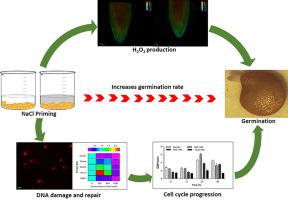Journal of Photochemistry and Photobiology B: Biology ( IF 5.4 ) Pub Date : 2020-10-10 , DOI: 10.1016/j.jphotobiol.2020.112050 Kodsara Ramachandra Kiran , Vishwanath Bhat Deepika , Puthanvila Surendrababu Swathy , Keshava Prasad , Shama Prasada Kabekkodu , Thokur Sreepathy Murali , Kapaettu Satyamoorthy , Annamalai Muthusamy

|
Reactive oxygen species (ROS) generated during rehydration of seeds is a major source of cellular damage. Successful germination depends on maintaining the oxidative window and ability of the cells to repair the DNA damage accumulated during seed developmental process, maturational drying, and germination. We explored the role of DNA damage, repair, cell cycle progression and antioxidant machinery in germination of seeds of Solanum melongena L. primed with 0, 320, 640 and 1200 mM sodium chloride (NaCl). The expression of antioxidant genes such as ascorbate peroxidase (APX), superoxide dismutase (SOD), catalase2 (CAT2), and glutathione reductase (GR) was upregulated to maintain the oxidative window required for germination in seeds treated with 320 mM NaCl. ROS generated upon treatment with 320 mM NaCl resulted in minimal DNA damage and activated non-homologous end joining (NHEJ) and mismatch repair (MMR) pathway genes such as KU70 and mutS homolog 2 (MSH2) respectively. Treatment with higher concentrations of NaCl resulted in increased DNA damage despite lower ROS, without evoking DNA repair mechanisms. Uncontrolled rehydration resulted in higher levels of ROS and DNA damage, but activation of homologous recombination (HR) pathway gene, Nijmegen breakage syndrome 1 (NBS1), and genes involved in repairing oxidized guanine, such as oxoguanine DNA glycosylase (OGG1) and proliferating cell nuclear antigen (PCNA). In summary, controlled rehydration with 320 mM NaCl decreased the DNA damage, reactivated the antioxidant and DNA repair machinery, and cell cycle progression, thereby enhancing the seed germination.
中文翻译:

NaCl引发种子萌发过程中ROS依赖的DNA损伤和修复
种子补液过程中产生的活性氧(ROS)是细胞损伤的主要来源。成功的发芽取决于维持氧化窗口以及细胞修复在种子发育,成熟干燥和发芽过程中积累的DNA损伤的能力。我们探讨了DNA损伤,修复,细胞周期进程和抗氧化剂机制在用0、320、640和1200 mM氯化钠(NaCl)引发的茄子种子发芽中的作用。抗氧剂基因如抗坏血酸过氧化物酶(APX),超氧化物歧化酶(SOD),过氧化氢酶2(CAT2)和谷胱甘肽还原酶(GR)的表达。将其上调以维持用320 mM NaCl处理的种子发芽所需的氧化窗口。用320 mM NaCl处理后产生的ROS导致最小的DNA损伤,并激活了非同源末端连接(NHEJ)和错配修复(MMR)途径基因,例如KU70和mutS homolog 2(MSH2)。尽管ROS较低,但用较高浓度的NaCl处理仍会导致DNA损伤增加,而没有引起DNA修复机制。无节制的补液导致较高水平的ROS和DNA损伤,但激活同源重组(HR)通路基因,奈梅亨断裂综合症1(NBS1)以及涉及氧化鸟嘌呤修复的基因,例如氧鸟嘌呤DNA糖基化酶(OGG1))和增殖细胞核抗原(PCNA)。总而言之,用320 mM NaCl进行受控补液可减少DNA损伤,重新激活抗氧化剂和DNA修复机制,以及细胞周期进程,从而增强种子发芽。



























 京公网安备 11010802027423号
京公网安备 11010802027423号